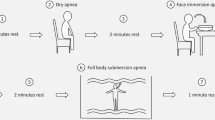Abstract
Breath-hold divers train and compete in maximal apnea performance. Glossopharyngeal inhalation (GI) is commonly used to increase lung volume above vital capacity (VC) prior to apnea. We investigated the hypothesis that this practice would increase apnea performance and relaxed airway pressure. Seven well-trained breath-hold divers performed maximal bouts of apnea at three different lung volumes (85% VC, VC and VC + GI) both at rest (dry static apnea) and during underwater swimming (dynamic apnea). Heart rate, apnea time and end tidal PCO2 and PO2 (P ET CO2 and P ET O2) were recorded. In addition, relaxed airway pressure was measured after GI. Maximal GI increased lung volume by 1.59±0.57 l above VC and increased relaxed airway pressure to from 3.5±0.5 to 8.7±1.7 kPa. Dry static apnea time was higher at VC + GI (346±46 s) than at VC (309±38 s, P<0.05) and 85% VC (297±48 s, P<0.01). Likewise, dynamic apnea time was higher at VC + GI (97±27 s) than at VC (78±14 s, P<0.05) and 85% VC (71±17 s, P<0.05). P ET O2 values reached 3.5±0.6 kPa at the end of dry static apnea bouts and this was not different from dynamic apnea when taking hydrostatic pressure at swimming depth into account (3.7±0.6 kPa, P=0.48). In conclusion, GI increases lung volume, relaxed airway pressure and apnea performance in well-trained breath-hold divers.



Similar content being viewed by others
References
Andersson J, Schagatay E (1998) Effects of lung volume and involuntary breathing movements on the human diving response. Eur J Appl Physiol Occup Physiol 77:19–24
Bergman SA Jr, Campbell JK, Wildenthal K (1972) Diving reflex in man: its relation to isometric and dynamic exercise. J Appl Physiol 33:27–31
Carey CR, Schaefer KE, Alvis HJ (1956) Effect of skin diving on lung volumes. J Appl Physiol 8:519–523
Craig AB Jr (1976) Summary of 58 cases of loss of consciousness during underwater swimming and diving. Med Sci Sports 8:171–175
Ferretti G, Costa M, Ferrigno M, Grassi B, Marconi C, Lundgren CE, Cerretelli P (1991) Alveolar gas composition and exchange during deep breath-hold diving and dry breath holds in elite divers. J Appl Physiol 70:794–802
Hong SK, Lin YC, Lally DA, Yim BJ, Kominami N, Hong PW, Moore TO (1971) Alveolar gas exchanges and cardiovascular functions during breath holding with air. J Appl Physiol 30:540–547
Lin YC (1982) Breath-hold diving in terrestrial mammals. Exerc Sport Sci Rev 10:270–307
Lindholm P, Gennser M (2005) Aggravated hypoxia during breath-holds after prolonged exercise. Eur J Appl Physiol 93:701–707
Lindholm P, Nyren S (2005) Studies on inspiratory and expiratory glossopharyngeal breathing in breath-hold divers employing magnetic resonance imaging and spirometry. Eur J Appl Physiol 94:646–651
Muth CM, Radermacher P, Pittner A, Steinacker J, Schabana R, Hamich S, Paulat K, Calzia E (2003) Arterial blood gases during diving in elite apnea divers. Int J Sports Med 24:104–107
Örnhagen H, Schagatay E, Andersson J, Bergsten E, Gustafsson P, Sandström S (1998) Mechanisms of buccal pumping (lung packing) and its pulmonary effects. Manuscripts for the XXIV annual scientific meeting of the European Underwater and Baromedical Society 1998
Otis AB, Rahn H, Fenn WO (1948) Alveolar gas changes during breath holding. Am J Physiol 152:674–686
Quanjer PH, Tammeling GJ, Cotes JE, Pedersen OF, Peslin R, Yernault JC (1993) Lung volumes and forced ventilatory flows. Report Working Party Standardization of Lung Function Tests, European Community for Steel and Coal. Official Statement of the European Respiratory Society. Eur Respir J Suppl 16:5–40
Rahn H, Otis AB, Chadwick LE, Fenn WO (1946) The pressure–volume diagram of the thorax and lung. Am J Physiol 146:161–178
Schaefer KE, Allison RD, Dougherty JH Jr, Carey CR, Walker R, Yost F, Parker D (1968) Pulmonary and circulatory adjustments determining limits of depths in breathhold diving. Science 162:1020–1023
Sterba JA, Lundgren CE (1985) Diving bradycardia and breath-holding time in man. Undersea Biomed Res 12:139–150
Wilmore JH (1969) A simplified method for determination of residual lung volumes. J Appl Physiol 27:96–100
Acknowledgments
We thank M.D. Henrik Staunstrup for acting as a clinically responsible supervisor for the project and for being present during all the experiments requiring clinical surveillance. We thank the divers of Aarhus free-diving club for their participation in the study.
Author information
Authors and Affiliations
Corresponding author
Rights and permissions
About this article
Cite this article
Overgaard, K., Friis, S., Pedersen, R.B. et al. Influence of lung volume, glossopharyngeal inhalation and P ET O2 and P ET CO2 on apnea performance in trained breath-hold divers. Eur J Appl Physiol 97, 158–164 (2006). https://doi.org/10.1007/s00421-006-0156-2
Accepted:
Published:
Issue Date:
DOI: https://doi.org/10.1007/s00421-006-0156-2




